How To Cheaply Repair Tiny Rust Spots On Car
How to Repair Rust on a Car
As long as vehicle body panels are made from steel, they're going to rust.
Introduction
Sooner or later, rust on cars is inevitable. Yet, if you deal with rust early, you lot can stop it from spreading and squeeze a few actress years out of your vehicle.
Rust repair isn't difficult, but it is time-consuming (mostly waiting for primer and paint to dry between steps). Plan to spend about $100 on supplies similar sandpaper, primer, masking tape and poly sheeting, a tack rag, polishing compound and touch-upwardly pigment and articulate glaze. Choose a at-home, overcast day and cake out the total twenty-four hour period to gear up the most common rust spots on the hood and doors.
Project stride-by-stride (nine)
Step ane
Become Shopping for Supplies
- First, detect the machine manufacturer's paint code.
- Note: The pigment code tin can be in a variety of places on the trunk, in the engine compartment or trunk, or other places. Use either of these online resources to discover instructions on how to locate your paint code: automotivetouchup.com or duplicolor.com.
- Buy automotive touch-upwards paint in pints and quarts to employ in a spray gun, in aerosol cans, or in roller ball applicators.
- Pro tip: Even if you know how to utilise a spray gun, mixing automotive paint with a reducer to match the temperature and humidity weather can be mighty tricky. Nosotros don't recommend it. Instead, buy droplets cans for larger repairs and rollerball applicators to fix scratches.
- Annotation: Almost late-model vehicles were painted with base glaze/clear coat pigment. The base coat contains just the pigment and binding resins-the clear glaze is just the gloss.
- Buy equal amounts of both base coat and clear coat.
- Y'all'll also need an epoxy self-carving primer to bite into the bare metallic and a lacquer primer to hold the paint.
- Buy 40-, 600- and 1,000-grit sandpaper, a sanding block, grease and wax remover, poly sheeting, painter'south tape, a tack rag and a microfiber material.
Step two
Mask Off the Repair Area
- Record the leading border of poly sheeting a few feet away from the repair then you'll have room to blend the touch-upward paint into the good areas.
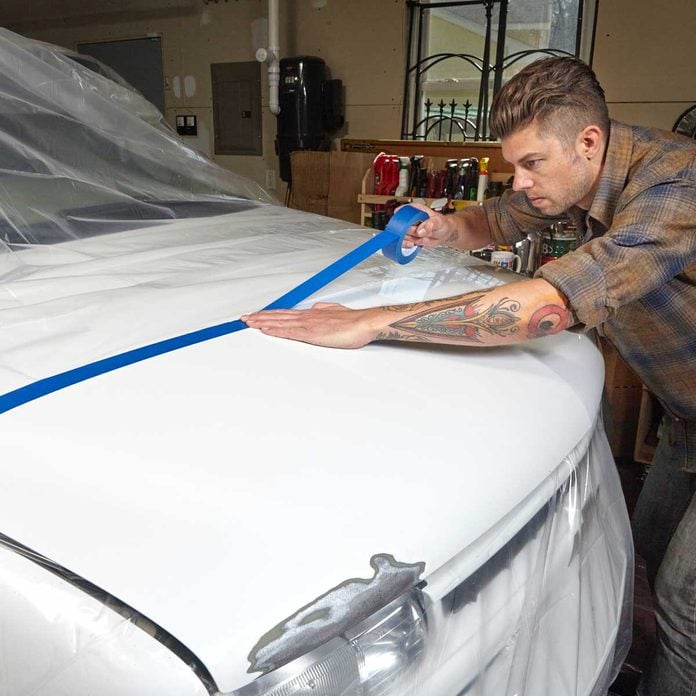
Pace 3
Remove the Rust
- Crack off any blistered pint with a scraper.
- Sand through the rust spots down to the bare metal, using 40-grit sandpaper.
- Enlarge the sanded expanse and so you'll have space to plumage the edges.
- Switch to 120-grit sandpaper to feather the edges of the repair area.
- Complete the feathering with 220 dust.
- Utilize a tack rag to remove particles from the unmasked area.
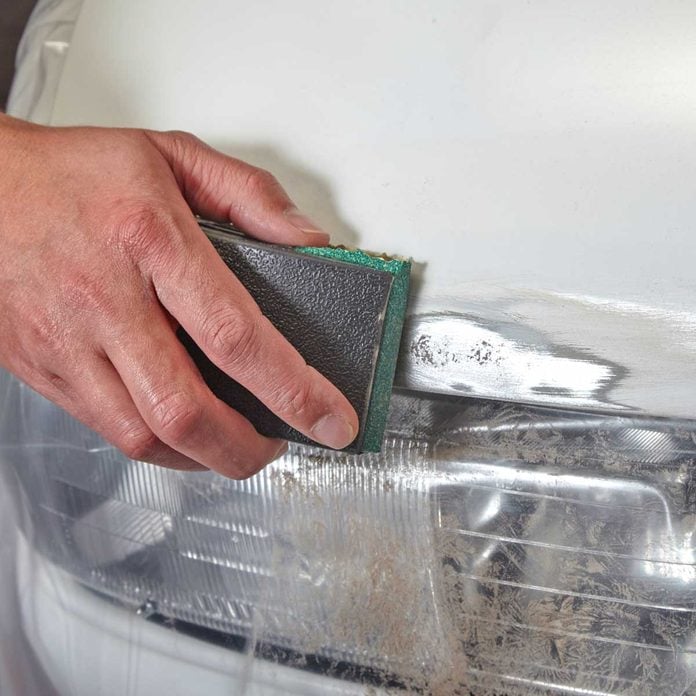
Footstep four
Make clean with Detergent
- If the rust has created pits in the metal, you can fill them now with torso filler or wait until the epoxy primer dries and apply multiple coats of filler primer.
- Clean the entire unmasked expanse with a grease-cut dishwashing detergent, followed by clean rinse water.
- Let it dry out.
- Wipe the area with a lint-free cloth to remove whatsoever remaining dust or lint.
- Employ the paint manufacturer'southward prep solvent.

Footstep 5
Apply Epoxy Primer, Then Filler Primer
- Spray the filler primer in heavier coats to cover the entire repair area.
- Move the can away from the surface slightly and alloy it into the surrounding painted area.
- Pro tip: Self-etching epoxy primer provides a potent bond to blank metal, so utilize information technology equally your first coat.
- Spray 2 to three medium coats, assuasive the recommended look time listed on the characterization (usually fifteen minutes) between coats.
- Expect a total hour for the epoxy to dry to the touch (longer if it's humid exterior).
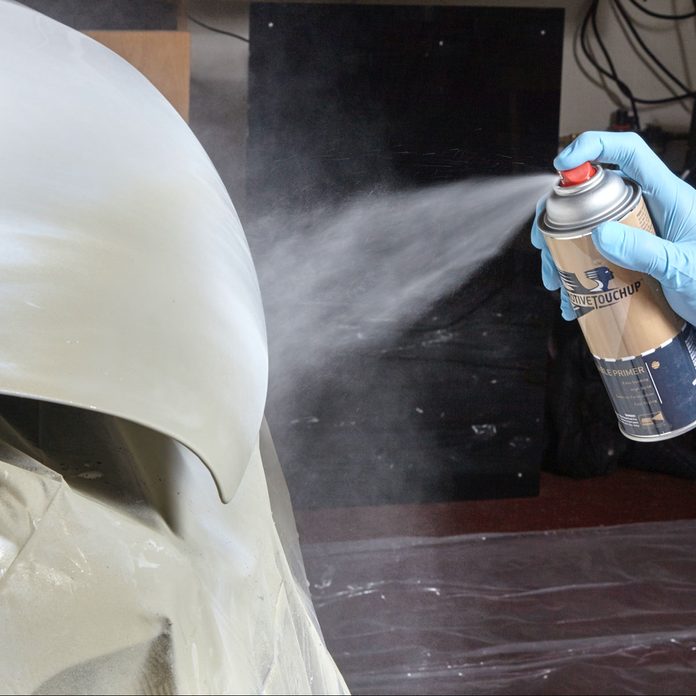
Pace 6
Sand the Primer
- Starting with wet 600-grit sandpaper, smooth the primer and plumage the edges.
- Switch to wet 1,000-grit sandpaper to final-sand the entire repair, including the blended areas.
- Launder with clear water and permit dry out.
- Wipe the dried epoxy primer with a lint-free textile.
- Utilise two to 3 heavier coats of lacquer filler primer, assuasive drying fourth dimension betwixt each coat.
- Let the lacquer primer dry until it'due south dry to the touch—at least one hour—before sanding.
- Sand drips and sags with 320-dust sandpaper.
- Then final-sand the unabridged repair area.
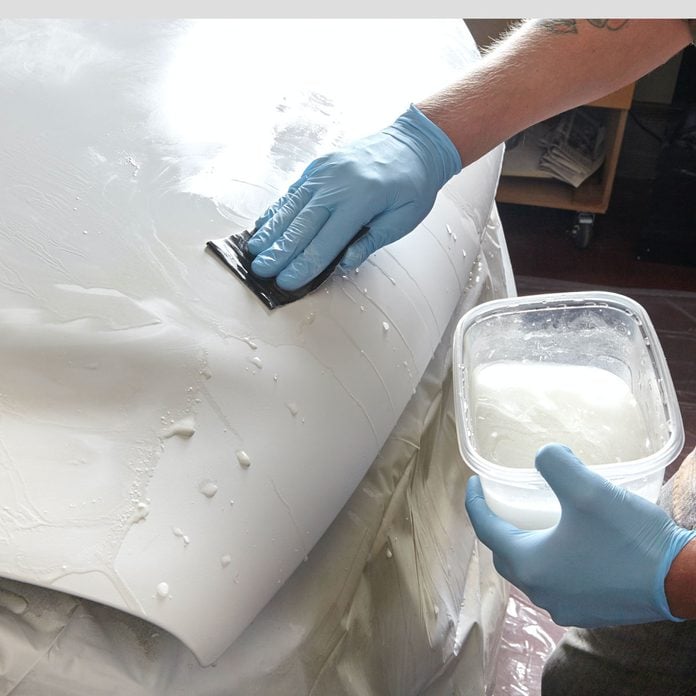
Footstep 7
Apply the Colored Base Coat
- Holding the spray tin about 12 in. abroad from the surface, spray the repaired area.
- Start at the lesser of the repair and utilise the color glaze in left-to-right rows, overlapping each pass by virtually one-third.
- Build the color slowly into the repair and surrounding areas in two to three coats.
- Allow about 10 to 15 minutes between coats.
- Allow the base glaze to dry, until information technology's dry to the impact, at least 60 minutes.
- Pro tip: Don't sand the base coat (especially metallic colors) unless you've created sags. In that case, sand lightly and then respray the touched-up areas.
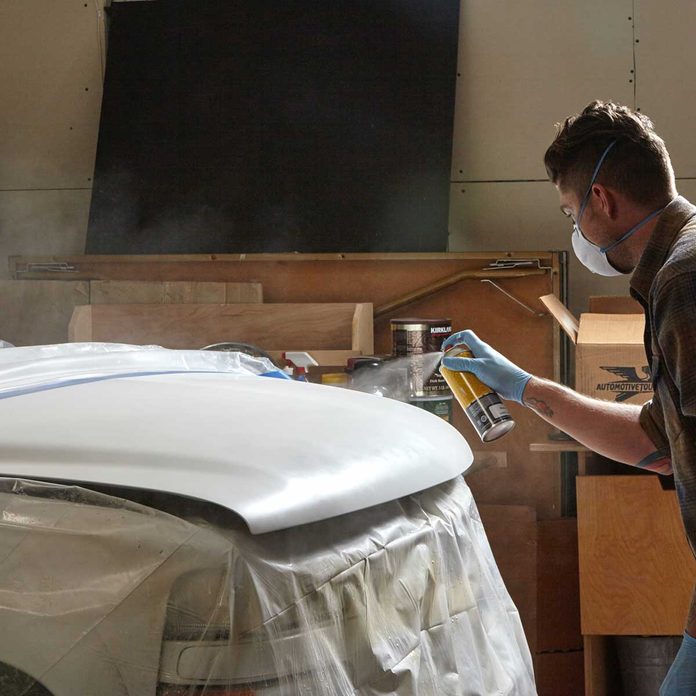
Step 8
Spray on the Articulate Coat
- Utilize several coats of clear coat, allowing the recommended drying time between coats.
- Gradually work the clear coat into the surrounding painted areas to achieve a smooth alloy line.
- Note: This is the hardest office because all clear coats run easily and that will ruin the expect of your paint job. If you lot create a run in the clear coat, you'll accept to let it dry for at to the lowest degree 48 hours earlier attempting to gear up it with fine-grit sandpaper and polishing chemical compound. Then y'all'll take to respray the sanded surface area. Then practice spraying on a scrap piece of cardboard to get a experience for the nozzle and the speed of application.
- Let the clear coat dry for several hours before driving the vehicle and at least 48 hours before buffing.
Footstep 9
Buff the Repair
- Using an sometime cotton T-shirt or microfiber cloth and buffing compound, hand-buff the repaired area.
- Pro tip: Don't use a polishing machine for this step. Await at to the lowest degree thirty days before waxing.
Originally Published: Dec 31, 2022
How To Cheaply Repair Tiny Rust Spots On Car,
Source: https://www.familyhandyman.com/project/how-to-repair-rust-on-a-car/
Posted by: smithpludenis.blogspot.com

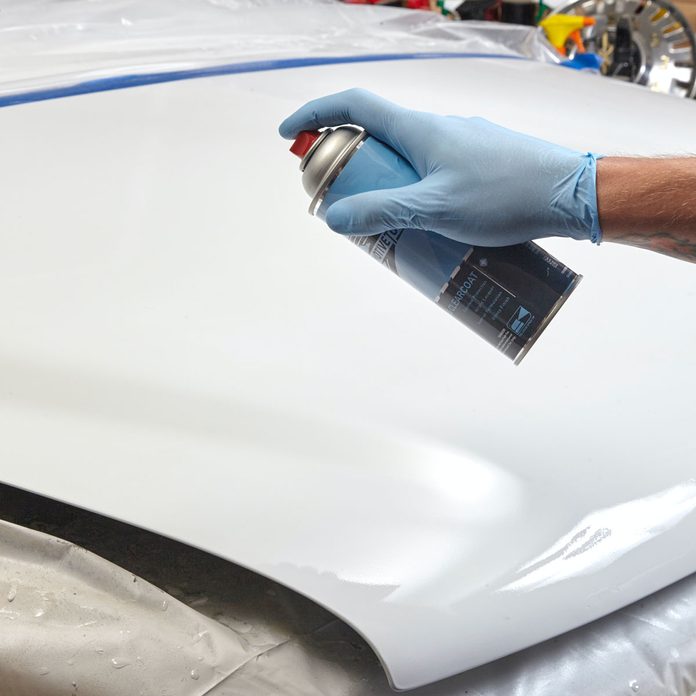

0 Response to "How To Cheaply Repair Tiny Rust Spots On Car"
Post a Comment